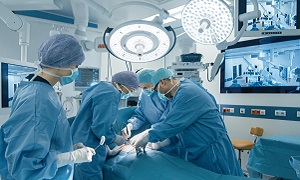Thoracoscopy
Thoracoscopy is a procedure which helps a doctor to look at the space inside your chest, outside your lungs. This is done using an instrument known as a thoracoscope, a thin, flexible tube with a light attached with a small video camera on the end.
Thoracoscopy is also sometimes done as part of a video-assisted thoracic surgery.
Purpose
Thoracoscopy is performed for multiple reasons. If you are having trouble breathing or you are coughing up blood, a thoracoscopy can help you know the cause of these problems.
If you are having excess fluid around the lung, ‘which is causing trouble breathing, thoracoscopy can help remove it. After the removal, if the fluid builds up again, then medicine can be put in the chest cavity with thoracoscopy for keeping the fluid from coming back.
This procedure can also be used for looking at an abnormal area seen on an imaging test, such as a CT scan or a chest X-ray. It can be also used for taking biopsy samples, or lymph nodes, abnormal lung tissue, the chest wall or the lining of the lung. It is commonly used for people suffering from mesothelioma and lung cancer.
Sometimes thoracoscopy can be used for treating small lung cancers, by removing just the part of the lung, which contains the tumor. In some cases, it is also used for treating cancers of the esophagus or thymus gland.
Preparation
Make sure that your health care provider knows about any medications that you are taking, including herbs, vitamins and supplements. Let him/her know if you have any allergies to medications.
You might be asked to stop taking blood-thinning medications for some days before your test. You might also be required to not eat or drink anything at least several hours before the procedure. Make sure you follow the instructions of your doctor.
Procedure
Generally, thoracoscopy is often performed as an outpatient procedure, and you generally don’t need to stay at the hospital overnight. Sometimes, you might need to stay at the hospital overnight for some days, depending on your procedure.
First, your doctor will be using local or general anesthesia, so that you won’t feel any pain and will be unconscious during the procedure. You will have a tube put into your throat, which will be hooked on to a breathing machine while the procedure is being done.
Next, a small cut will be made on the back just below the tip of your shoulder blade between the two ribs. Then the thoracoscope will be inserted.
Then another small cut is made below your underarm on the same side so the instrument with the cutting tool can be put in. Some of the air in your lung on that side might be released, to make it easy to see any abnormal areas. After this, any abnormal areas might be removed or biopsied with the cutting tool and checked in the lab.
If fluid needs removal, a third cut can be made in the lower chest wall, and a flexible catheter called a chest tube is put in so that fluid can drain out over a few days. The thoracoscope and cutting tool is next removed then the cuts are closed. Once the procedure is complete, you will be woken up gently and taken off the breathing machine.
This procedure should take between 30 and 90 minutes. Depending on what is being done, it can sometimes take longer.
After the test
After this procedure, you will need to be watched closely, so that you don’t suffer from any problems. You might feel a bit confused as the anesthesia wears off and your mouth and throat might also be numb for a few hours. You will not be allowed to eat or drink until the numbness has worn off.
After the numbness is gone, you might be having a sore throat, cough or hoarseness for the next day or so. You might also experience pain or numbness in the sites where the cuts were made. You will need a ride home, so make sure that you arrange one in advance.
If transportation is a problem, talk with your health care provider regarding the policy at your hospital. You will receive instructions from your doctor regarding what you will not be able to do after the procedure.
If the procedure was performed under general anesthesia, you will likely need to stay at the hospital for a few days. If a chest tube was put in for drawing off fluid, it might be removed in a few days after the draining has stopped.
If biopsies were done as a part of the procedure, then the results should typically come in a few days. Make sure that you follow up with your doctor, after your procedure for getting your results soon.
Risks
Few risks are associated with this procedure which includes:
- Bleeding
- Pneumonia i.e. infection in the lung
- Collapse of part of a lung i.e. pneumothorax
- Incisions getting infected


